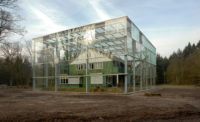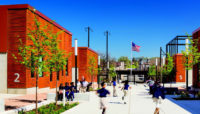How Isamu Noguchi Tried to Change a Japanese Prison Camp

Isamu Noguchi’s Yellow Landscape, 1943.
Photo © The Isamu Noguchi Foundation and Garden Museum/ Kevin Noble

Noguchi’s proposed cemetery plan for Poston.
Photo © The Isamu Noguchi Foundation and Garden Museum/ Kevin Noble

A 1942 masterplan proposal for the Poston camp.
Photo © The Isamu Noguchi Foundation and Garden Museum/ Kevin Noble

Untitled, 1943.
Photo © The Isamu Noguchi Foundation and Garden Museum/ Kevin Noble

Double Red Mountain, 1969.
Photo © The Isamu Noguchi Foundation and Garden Museum/ Kevin Noble

Installation view, Self-Interned, 1942: Noguchi in Poston War Relocation Center
Photo © The Isamu Noguchi Foundation and Garden Museum/ Nicolas Knight

Installation view, Self-Interned, 1942: Noguchi in Poston War Relocation Center
Photo © The Isamu Noguchi Foundation and Garden Museum/ Nicolas Knight

Installation view, Self-Interned, 1942: Noguchi in Poston War Relocation Center
Photo © The Isamu Noguchi Foundation and Garden Museum/ Nicolas Knight

Doorway, 1964.
Photo © Nicolas Knight

Mother and Child, 1944–47.
Photo © Kevin Noble










In early 1942, shortly after the Japanese attacks on Pearl Harbor, President Franklin D. Roosevelt signed Executive Order 9066, a directive that sanctioned the deportation of thousands of Japanese Americans from the West Coast to internment camps across the nation.
As an East Coast resident, the acclaimed sculptor and designer Isamu Noguchi was exempted from this deportation. But nonetheless he voluntarily entered Arizona’s Poston War Relocation Center, hoping that he could use art to help ameliorate camp conditions. A new exhibit now on view at the Noguchi Museum in New York chronicles his initial optimism, subsequent disillusionment, and how the experience shaped his practice.
Coinciding with the 75th anniversary of Executive Order 9066, Self-Interned, 1942: Noguchi in Poston War Relocation Center shows objects and ephemera from his time in Poston. An ambitious 1942 camp blueprint, for example, depicts a meticulously planned site complete with an art center and amphitheater—even a miniature golf course. Letters document Noguchi’s requests for cost estimates for kilns, clay, and art supplies in order to instruct internees in traditional crafts. His vision for Poston included meandering paths and canals, a Japanese cemetery, as well as plantings of palm, fig, and mesquite.
“Noguchi was an incredible idealist and an activist,” says curator Dakin Hart. “He really believed he could galvanize the camp in the fight against fascism.”
But it soon becomes clear that the camp never planned to implement Noguchi’s ideas, leaving the idealist deflated. To make matters worse, the Japanese Americans in the camp didn’t fully accepted the designer, with some “viewing him as a tool of the government,” explains Hart. Noguchi requested to leave Poston after two months. It ultimately took him seven to get released.
In a letter to Man Ray, Noguchi wrote, “This is the weirdest, most unreal situation—like in a dream –I wish I were out... Here time has stopped and nothing is of any consequence, nothing of any value, neither our time or our skill.”
When Noguchi emerged from Poston, in November 1942, he was a changed artist. Rather than concentrating on figurative pieces, as he had before, he began vacillating between satirical jabs and abstract works. For example, My Arizona, a white fiberglass and Plexiglas wall sculpture, evokes a barren desert with abstracted buttes and mesas. Other projects hint at trauma: This Tortured Earth, a bronze relief scarred by gashes, is a 1942 proposal for a massive earthwork to be created by aerial bombardment.
It is only later, in the ‘60s and ‘70s, that his work becomes more meditative, with bronze, stone, and stainless-steel sculptures recalling portals, voids, and doorways. They suggest transcendence, a movement toward a better tomorrow. “To be hybrid anticipates the future,” Noguchi wrote. “This is America, the nation of all nationalities.”
Given the political climate, it’s an apt message for the times.
Self-Interned, 1942: Noguchi in Poston War Relocation Center is on view at the Noguchi Museum through January 7, 2018.












